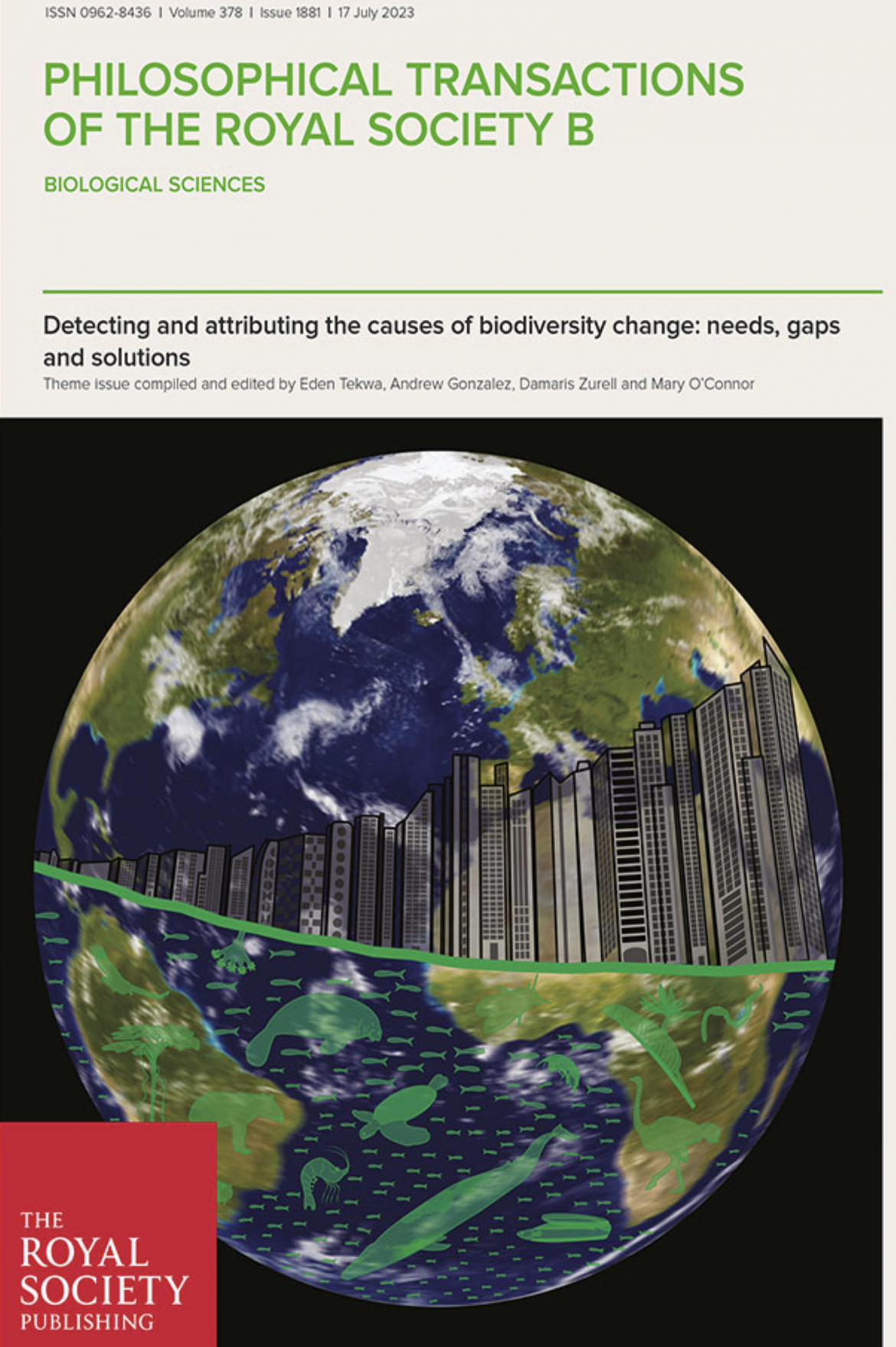
Cover image: This issue addresses the need for rigorous assessments on biodiversity change around the world in response to a growing human footprint. In this cover image, the increasing produced capital outlined by buildings and declining natural capital traced by the organism boundary are based on Managi, Chapter 1 in Inclusive Wealth Report 2018.
Illustration by Sylvia Heredia and Eden Tekwa. Earth image rendered from NASA Visible Earth.
Theme issue: ‘Detecting and attributing the causes of biodiversity change: needs, gaps and solutions’ compiled and edited by Eden Tekwa, Andrew Gonzalez, Damaris Zurell and Mary O’Connor - Philosophical Transactions of the Royal Society B
This theme issue addresses the multifaceted problems of tracking biodiversity change to meet emerging international development goals, national economic accounting, and diverse community interests. The contributions address six major aspects of biodiversity assessment: connecting policy to science, establishing observation, improving statistical estimation, detecting change, attributing causes, and projecting the future. These studies are led by experts in Indigenous studies, economics, ecology, conservation, statistics, and computer science, with representations from Asia, Africa, South America, North America, and Europe. The results place biodiversity science in the context of policy needs, and provide an updated roadmap for how to acquire, process, and use biodiversity observation data in a changing world.
UBC - Biodiversity Research Centre/Department of Botany/Department of Zoology led papers:
Eden Tekwa, Andrew Gonzalez, Damaris Zurell and Mary O'Connor. 2023. Detecting and attributing the causes of biodiversity change: needs, gaps and solutions
Abstract
This issue addresses the multifaceted problems of understanding biodiversity change to meet emerging international development and conservation goals, national economic accounting and diverse community needs. Recent international agreements highlight the need to establish monitoring and assessment programmes at national and regional levels. We identify an opportunity for the research community to develop the methods for robust detection and attribution of biodiversity change that will contribute to national assessments and guide conservation action. The 16 contributions of this issue address six major aspects of biodiversity assessment: connecting policy to science, establishing observation, improving statistical estimation, detecting change, attributing causes and projecting the future. These studies are led by experts in Indigenous studies, economics, ecology, conservation, statistics, and computer science, with representations from Asia, Africa, South America, North America and Europe. The results place biodiversity science in the context of policy needs and provide an updated roadmap for how to observe biodiversity change in a way that supports conservation action via robust detection and attribution science.
Andrew Gonzalez, Jonathan M. Chase and Mary I. O’Connor. 2023. A framework for the detection and attribution of biodiversity change
Abstract
The causes of biodiversity change are of great scientific interest and central to policy efforts aimed at meeting biodiversity targets. Changes in species diversity and high rates of compositional turnover have been reported worldwide. In many cases, trends in biodiversity are detected, but these trends are rarely causally attributed to possible drivers. A formal framework and guidelines for the detection and attribution of biodiversity change is needed. We propose an inferential framework to guide detection and attribution analyses, which identifies five steps—causal modelling, observation, estimation, detection and attribution—for robust attribution. This workflow provides evidence of biodiversity change in relation to hypothesized impacts of multiple potential drivers and can eliminate putative drivers from contention. The framework encourages a formal and reproducible statement of confidence about the role of drivers after robust methods for trend detection and attribution have been deployed. Confidence in trend attribution requires that data and analyses used in all steps of the framework follow best practices reducing uncertainty at each step. We illustrate these steps with examples. This framework could strengthen the bridge between biodiversity science and policy and support effective actions to halt biodiversity loss and the impacts this has on ecosystems.
Eden W. Tekwa, Matthew A. Whalen, Patrick T. Martone and Mary I. O’Connor. 2023. Theory and application of an improved species richness estimator
Abstract
Species richness is an essential biodiversity variable indicative of ecosystem states and rates of invasion, speciation and extinction both contemporarily and in fossil records. However, limited sampling effort and spatial aggregation of organisms mean that biodiversity surveys rarely observe every species in the survey area. Here we present a non-parametric, asymptotic and bias-minimized richness estimator, Ω by modelling how spatial abundance characteristics affect observation of species richness. Improved asymptotic estimators are critical when both absolute richness and difference detection are important. We conduct simulation tests and applied Ω to a tree census and a seaweed survey. Ω consistently outperforms other estimators in balancing bias, precision and difference detection accuracy. However, small difference detection is poor with any asymptotic estimator. An R-package, Richness, performs the proposed richness estimations along with other asymptotic estimators and bootstrapped precisions. Our results explain how natural and observer-induced variations affect species observation, how these factors can be used to correct observed richness using the estimator Ω on a variety of data, and why further improvements are critical for biodiversity assessments.